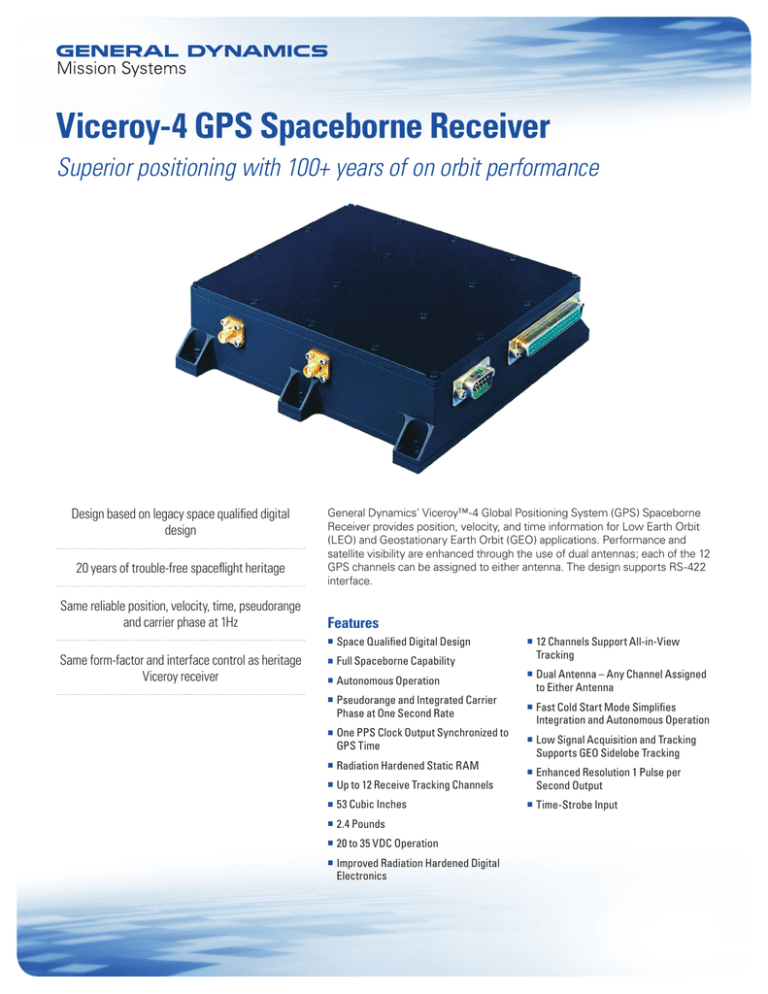
Viceroy-4 GPS Spaceborne Receiver
Superior positioning with 100+ years of on orbit performance
Design based on legacy space qualified digital
design
20 years of trouble-free spaceflight heritage
Same reliable position, velocity, time, pseudorange
and carrier phase at 1Hz
General Dynamics’ Viceroy™-4 Global Positioning System (GPS) Spaceborne
Receiver provides position, velocity, and time information for Low Earth Orbit
(LEO) and Geostationary Earth Orbit (GEO) applications. Performance and
satellite visibility are enhanced through the use of dual antennas; each of the 12
GPS channels can be assigned to either antenna. The design supports RS-422
interface.
Features
nn
Space Qualified Digital Design
Same form-factor and interface control as heritage
Viceroy receiver
nn
Full Spaceborne Capability
nn
Autonomous Operation
nn
Pseudorange and Integrated Carrier
Phase at One Second Rate
nn
One PPS Clock Output Synchronized to
GPS Time
nn
Radiation Hardened Static RAM
nn
Up to 12 Receive Tracking Channels
nn
53 Cubic Inches
nn
2.4 Pounds
nn
20 to 35 VDC Operation
nn
Improved Radiation Hardened Digital
Electronics
nn
12 Channels Support All-in-View
Tracking
nn
Dual Antenna – Any Channel Assigned
to Either Antenna
nn
Fast Cold Start Mode Simplifies
Integration and Autonomous Operation
nn
Low Signal Acquisition and Tracking
Supports GEO Sidelobe Tracking
nn
Enhanced Resolution 1 Pulse per
Second Output
nn
Time-Strobe Input
Standard positioning service in space
Performance Characteristics
Optional and Custom Features
nn
Serial Port – 1553 or standard RS422
Receiver Architecture
nn
Code Types: L1 C/A
nn
12 channels with enhanced fast acquisition
nn
Kalman filter or least squares solution
nn
Dual antenna – any channel to either antenna
nn
Single string or redundant configurations
nn
L1: 1575.42 MHz, C/A code
nn
Low signal acquisition and tracking to 20 dB-Hz (GEO side lobes)
nn
Carrier-aided code tracking
nn
Precision internal reference Ovenized Crystal Oscillator (OCXO)
nn
Based on legacy Viceroy architecture (hardware and software)
nn
External 10 MHz reference oscillator
nn
Time Strobe Input: < 100 ns, 1 sigma
Input/Output
nn
RS-422 serial I/O (standard)
Antenna
nn
MIL-STD-1553B (optional)
nn
Active microstrip patch antenna (LEO), 0.4 lbs
nn
X.25 protocol with ECEF position, velocity, time, longitude, latitude,
nn
High gain multi-element antenna (GEO), 1.0 lb
pseudorange, carrier phase
nn
One pulse per second (GPS, UTC, or Measurement Epoch Time)
nn
Time strobe input signal
nn
9-pin male Mirco-D for prime power
nn
37-pin female Sub-D for command and telemetry
Solution Accuracy
nn
Autonomous Position: < 15 meters, 1 sigma
nn
Autonomous Velocity: < 0.05 meters/second, 1 sigma
nn
1PPS time: < 100 ns, 1 sigma
nn
Power supplied by Viceroy-4
nn
SMA female connection on receiver and antenna
Physical/Environmental
nn
Size: 6.0” x 5.2” x 1.7” (152 x 132 x 43 mm)
nn
Weight: 2.4 lbs (1.1 kg) max
nn
DC Power: 7 W max; steady-state tracking (20-35 V)
nn
Vibration: 17 Grms
nn
Shock: 1750 G @ 500 Hz
nn
Temperature: -20°C to +60°C
Time to First Fix
nn
60 seconds, cold start
Orbital Dynamics
nn
Altitude: LEO to GEO (200 km – 45,000 km)
nn
Velocity: up to 16,000 meters/second
nn
Acceleration: 1G
Joseph Verderame • Manager, Business Development • 480.586.9973 • joseph.verderame@gd-ms.com • gdmissionsystems.com/space
©2015 General Dynamics. All rights reserved. General Dynamics reserves the right to make changes in its products and specifications at anytime and without notice. All trademarks
indicated as such herein are trademarks of General Dynamics. All other product and service names are the property of their respective owners. ® Reg. U.S. Pat. and Tm. Off.
D-VICEROY-01-1115


